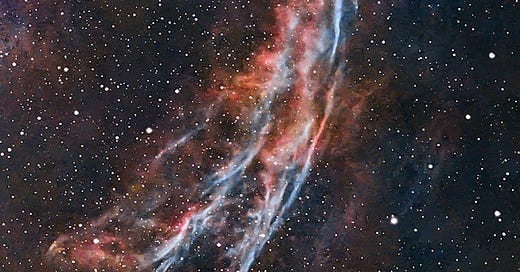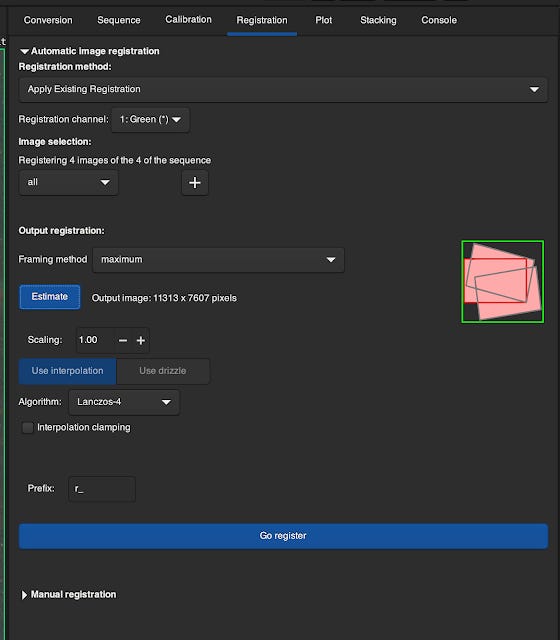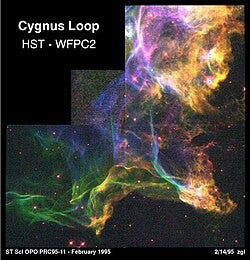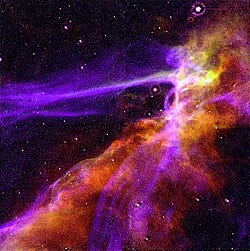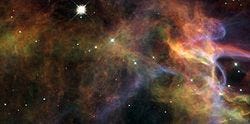The Cygnus Loop and Western Veil Nebula - 15 Jun 2025
Seestar S50, FF65-APO / ASI2600MC-Pro Duo / Askar D1 / ZWO AM3
NGC 6990 - The Western Veil Nebula
480 x 20s subs
Seestar S50
After a week of clouds and rain we had some last-minute clearing here in SE Michigan. Clouds were forecast, but Astrosphere.com was showing clearing between 10 pm - 3 am. At 9 pm my Seestar App was showing 75% visibility all night long but skies were cloudless. So I grabbed the scopes and headed across the street to the W-H Observatory (Katrina's lawn) and set up for hopefully a night of imaging.
Astrosphere.com was showing clear skies until 6 am so I set up a Mosaic in the ASIAir Plus to capture 4 frames of 15 x 300s each of the Cygnus Loop (NGC 6960) that includes the Eastern Veil and Western Veil Nebulas. Weather.com however, showed only 25% visibility at 3 am so I shortened the Plan Mode to take only 10 x 300s subs for each of the 2X2 Mosaic as I figured I'd have to wait until after 11pm to start imaging and have to quit by 3 am.
At 9:30 pm, however, I was able to see some stars with the ASI2600MC-Pro Duo (without filter) so I started a Polar Alignment. By 10:20 pm I was aligned, and was autoguide-calibrating on the star Unukalhai along the Equator at the Meridian. With the Askar D1 filter now between the camera and the FF65-APO Quintuplet I was now able to slew to NGC 6960, Auto-focus, begin guiding (~0.8 - 1.0" error) and start capturing. Despite the less-than good guiding I was able to get a sharp 300s exposure of the first of 4 frames of the mosaic.
Meanwhile I had the Seestar S50 polar aligned in EQ Mode and was "trying" to image The Western Veil Nebula portion of the Cygnus Loop. I was getting only ~50% efficiency on 20 s exposures, so I stopped and restarted the routine several times before I stopped seeing gradients and started getting better efficiency as the target rose in the NE sky.
I woke at 3 am and saw clear skies outside. Skies were also clear at 4 am when I headed out to check progress of both scopes. The FF65-APO and the 4-frame Mosaic was completed. The Seestar S50 was showing only 2 hrs 40 min of 20 s captures (disappointing). But, the S50 stacked image looked really nice so I stopped acquisition to concentrate on the FF65-APO and ASI2600MC-Pro Duo.
Skies were still relatively dark so I decided to restart the ASIAir Plus and make the ASI220MM guide camera the Main Camera. This would allow me to use the Focus routine to better focus the guide camera. Once completed I attempted to calibrate the Auto Guide and found myself now getting 0.3 - 0.5" error. A 300s capture of V398 Cephei looked good, so I decided to try a 10-minute sub. 600s capture looked clean and sharp (no elongated stars). I was able to pack up for the evening.
I stacked the Seestar data in Siril Ver. 1.40 beta-2. Standalone GraXpert was used to perform Background Extraction, and Siril was then used to Plate Solve, Color Correct, and Stretch the image. I then ran Starnet++ to remove stars and generate Starless and Starmask images. Starless image was processed in Adobe Photoshop and the Starmask image was sharpened in Cosmic Clarity (Seti Astro Suite). Both images were the recombined in Siril and the Final image was touched up using Photoshop. See top image.
The Mosaic data processing was a bit complex but not horrible. Folders were set up for each Frame (1-1, 1-2, 2-1, and 2-2) that contained a copy of last night's Biases, Dark and Flat Calibration files. Lights were stored in a Lights folder. I had to go into Siril and download the following
script. This script does the same thing as the OSC_Preprocessing.ssf but runs background extraction before registering and stacking the individual Fits files.
(See Rich's process video at:
The script will generate a Result_*.fit file for each of the 4 Frames of the Mosaic. I renamed the stacked fits files (result_300s_1_1.fit, result_300s_1_2.fit, result_300s_2_1.fit, and result_300s_2_2.fit) as they were all labeled result_300s.fit.
To generate the Mosaic the four *_result_*.fit are added to the Conversion Tab in Siril and processed to generate a Sequence file. Before Registration, however, the new Sequence file needs to be Plate Solved so I had to go to \Tools\Astrometry\ImagePlateSolve and make sure to check the box "Solve Whole Sequence"
Once Plate Solved a green box will appear around the displayed image in Siril. Next step is to go to the Registration Tab and make sure the following items are selected:
- Apply Existing Registration
- Framing Method: Maximum
Hit the Estimate button to determine output file; it cannot exceed 32,768 px (otherwise you'll need to adjust Scaling to lower the file size below the 32K value.
Then Go Register.
The Stacking Tab is configured as such:
- Average stacking with rejection
- Additive with scaling
- Pixel Rejection = No rejection
- Border feathering = 50 - 100 (adjust to taste)
- Weighting = None
And Start Stacking. The mosaic will be built with hopefully no adjustments needed other than Cropping and performing image processing like you would a normal results_.fit file.
Unfortunately, in my case the upper right Frame gave me double-stars through misalignment:
I tried other models but only made things worse, so I tried using Seti Astro Suite's "Mosaic Master". I got a much better Mosaic image, so I saved their versioin and opened in Siril to process as I normally would:
Crop, Color Calibrate, Starnet++, Photoshop, etc... I came up with this final image in Photoshop:
Despite only 10 x 300 s for each Frame of the 2x2 Mosaic I am happy with this first attempt. I may need to be a bit more precise in selecting a good camera roation angle so that I don't get those dark corners and double-star defects.
According to Wikipedia:
The Cygnus Loop (radio source W78, or Sharpless 103) is a large supernova remnant (SNR) in the constellation Cygnus, an emission nebula measuring nearly 3° across.[1] Some arcs of the loop, known collectively as the Veil Nebula or Cirrus Nebula, emit in the visible electromagnetic range.[1] Radio, infrared, and X-ray images reveal the complete loop.
Visual components: the Veil Nebula
[edit]
Main article: Veil Nebula
The visual portion of the Cygnus Loop is known as the Veil Nebula, also called the Cirrus Nebula or the Filamentary Nebula. Several components have separate names and identifiers,[2][3] including the "Western Veil" or "Witch's Broom", the "Eastern Veil", and Pickering's Triangle.
NGC 6960
[edit]
NGC 6960, the Western Veil, is the western part of the remnant, also known as the "Witch's Broom", located at J2000 RA 20h 45m 58.1s Dec +30° 35′ 43″.[3] As the westernmost NGC object in the nebula (first in right ascension), its number is sometimes used as an NGC identifier for the nebula as a whole.
NGC 6992, NGC 6995, and IC 1340
[edit]
These three luminous areas make up the Eastern Veil. NGC 6992 is an HI shell located along the north-eastern edge of the loop at J2000 RA 20h 56m 19.0s Dec +31° 44′ 34″.[4] NGC 6995 is located farther south at J2000 RA 20h 57m 10.7s Dec +31° 14′ 07″,[5] and IC 1340 even farther south at J2000 RA 20h 56m 12.0s Dec +31° 04′ 00″.[6]
Pickering's Triangle
[edit]
Also known as Pickering's Wedge, or Pickering's Triangular Wisp, this segment of relatively faint nebulosity was discovered photographically in 1904 by Williamina Fleming at Harvard Observatory, where Edward Charles Pickering was director at the time. The Triangle is brightest along the northern side of the loop, though photographs show the nebulosity extending into the central area as well.
NGC 6974 and NGC 6979
[edit]
These two objects are generally identified today (as by the NGC/IC Project and Uranometria) with two brighter knots of nebulosity in a cloud at the northern edge of the loop, to the east of the northern edge of Pickering's Triangle. NGC 6979 was reported by William Herschel, and while the coordinates he recorded for Veil objects were somewhat imprecise,[7] his position for this one is tolerably close to the knot at J2000 RA 20h 50m 27.9s Dec +32° 01′ 33″.[7]
The identifier NGC 6979 is sometimes taken to refer to Pickering's Triangle,[8] but the Triangle is probably not what Herschel saw or what the Catalogue intended for this entry: it was discovered only photographically, after the Catalogue was published, and long after Herschel's observation.
NGC 6974 was reported by Lord Rosse, but the position he gave lies in an empty region inside the main loop. It was assumed that he recorded the position incorrectly, and the New General Catalogue gives Rosse's object as the other knot in the northern cloud, located at J2000 RA 20h 51m 04.3s Dec +31° 49′ 41″, one degree north of Rosse's position.[9] (This position is farther east than NGC 6979, even though NGC objects are generally ordered by increasing RA.) These filaments in the north-central area are sometimes known as the "carrot".[10] The spectrum at 34.5 MHz of the region associated with NGC 6974 ranges straight over the entire frequency range 25 to 5000 MHz.[11]
Southeastern knot
[edit]
The southeastern knot is located at J2000 RA 20h 56m 21.2s Dec +30° 23′ 59″ on the southeastern rim of the Cygnus Loop. The knot has been identified as an encounter between the blast wave from the supernova and a small isolated cloud.[12] The knot is a prominent X-ray feature, consisting of a number of filaments correlated with visual line emission.[12] By combining visual and X-ray data, it can be shown that the southeastern knot is an indentation on the surface of the blast wave, not a small cloud but the tip of a larger cloud.[12] The presence of a reverse shock is evidence that the knot represents an early stage of a blast wave encountering a large cloud.[12]
Distance
[edit]
Until 1999, the most often-quoted distance to the supernova remnant was a 1958 estimate made by R. Minkowski, combining his radial velocity measurements with E. Hubble's proper motion study of the remnant's optical filaments to calculate a distance of 770 parsecs or 2500 light-years.[13][14] However, in 1999, William Blair, assuming that the shock wave should be expanding at the same rate in all directions, compared the angular expansion along the sides of the bubble (visible in Hubble Space Telescope images) with direct line-of-sight measurements of the radial expansion towards the Earth and concluded that the actual size of the bubble was about 40% smaller than the conventional value, leading to a distance of about 1470 ly.[13][14]
A larger revised value of 540 pc (1760 ly) appeared to be corroborated by Blair's later discovery, via the Far Ultraviolet Spectroscopic Explorer (FUSE), of a star seemingly behind the Veil. A UV spectrum of this star, KPD 2055+3111 of spectral type sdOB, showed absorption lines in its spectrum indicate that its light is partially intercepted by the supernova remnant. With an estimated (but uncertain) distance of about 1860 ly away, this star seemed to support the revised estimate of 1760 ly.[14]
More recent investigations of the Cygnus Loop's distance using Gaia parallax measurements of several stars seen toward the Cygnus Loop have led to more accurate distance estimates.[15][16] One of these stars, a 9.6 magnitude B8 star (BD+31 4224) located near the remnant's northwestern rim shows evidence of interactions of its stellar wind with the Cygnus Loop's shock wave, thereby indicating it is located actually inside the remnant.[15] This star's Gaia estimated distance of around 730 pc, along with two other stars both at about 740 pc which exhibit spectral features indicating they must lie behind the remnant, leads to new distance of 725 15 pc or around 2400 light-years. The Gaia estimated distance to the sdOB star KPD 2055+3111 is 819 pc (2,670 ly). This new distance, surprisingly close to the value estimated some 60 years ago by Minkowski, means the Cygnus Loop is physically some 37 pc (120 ly) in diameter and has an age of around 20,000 years.[16]
Astronomical ultraviolet source
[edit]

The brightest far-ultraviolet sources of the Cygnus Loop occur in the north-east edge of the remnant. The first flight of the High Resolution Emission Line Spectrometer (HIRELS), a wide-field, far-ultraviolet nebular spectrometer, tuned to OVI emission lines, was launched aboard a Nike-Black Brant from White Sands Missile Range to observe the Cygnus Loop, the first observed galactic OVI emission line source.[17]
X-ray source
[edit]
The X-ray source Cygnus X-5 coincides with SNR G074.0-08.6 (the Cygnus Loop), located at J2000 RA 20h 51.1m Dec +30° 41′, observed by Uhuru at 4U 2046+31. This source also has catalogue numbers 1E 2049.4+3050, 1H 2050+310, and 1M 2051+309, having been observed by the Einstein Observatory, HEAO 1, and OSO 7, respectively.
The Cygnus Loop is a strong source of soft X-rays.[18]
The center of the supernova shell as determined from X-ray data lies at J1950 RA 20h 49m 45s Dec +30° 53′.[19] A characteristic thermal temperature averaged over the loop from X-ray spectral data is Tx = 2.9 ± 1.5 million K.[19] An X-ray surface brightness map of the loop was obtained with a one-dimensional X-ray telescope flown aboard an Aerobee 170 sounding rocket launched on March 30, 1973, from the White Sands Missile Range.[19]
Searches for a compact stellar remnant
[edit]
Most stars that produce supernovae leave behind compact stellar remnants- a neutron star or black hole, typically depending on the mass of the original star. Various techniques based on the features of the supernova remnant estimate the Cygnus Loop progenitor star's mass at 12 to 15 Solar masses,[20][21] a value that puts the expected remnant firmly within neutron star boundaries.[22] However, despite many searches, no compact stellar remnant had been confidently identified since the identification of the supernova remnant.
A noted anomaly is that in X-rays, the nebula appears perfectly spherical aside from a "blowout region" to the south. Searches for a compact stellar remnant have been largely concentrated here, as the hole may have been caused by the violent ejection of a neutron star.[22] A detailed 2012 study of the blowout region identified a possible pulsar wind nebula, as well as a point-like source within it. Although at almost exactly the same position as a known Seyfert galaxy, the slight offset combined with a lack of a radio counterpart makes the point-like source probably unrelated to the galaxy. Whether the feature is a pulsar wind nebula, and if so whether it is related to the Cygnus Loop, is still unknown for certain.[22] If it is indeed the compact stellar remnant of the supernova, the neutron star would have to have been ejected from the center of the nebula at a speed of roughly 1,850 km/s, depending on the precise age and distance of the remnant.[22]

